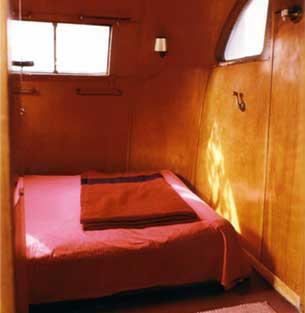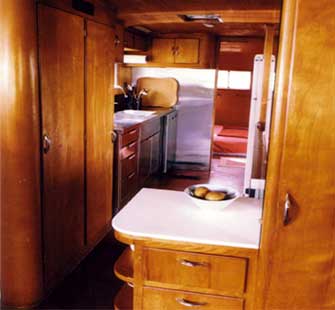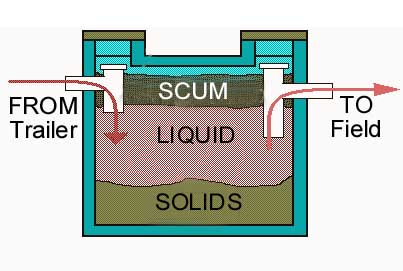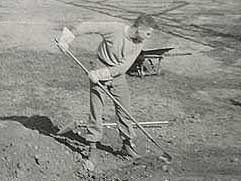LITTLE HOUSE ON THE HIGHWAY
One spring many, many years ago, two wide-eyed 18 year-olds married and set out in their covered wagon (1947 Chevy) to find a place in the sun. It would be easy – all they needed was a small plot of land, some shelter, a bit of food and water, and their love to carry them through!
Grandpa S. aided and abetted these dreamers. Some years previously the new highway had cut off a triangular piece of his farm and rendered that piece inaccessible and unusable to the farm. Grandpa S. offered the use of this lot. Somehow, the dreamers came up with a few dollars for a down payment and purchased a 23’ house trailer. So, that’s it, right. Park the trailer, move in, and life will be good! Well, not so much.
|
|
|
|
|
|
The land was in the country on the corner of a major highway and a local road. The highway had left a fairly deep ditch on their side of the triangle. The local road had a smaller ditch, but still too deep to haul a trailer through.
We acquired a significant concrete culvert to maintain water flow in the ditch and, using a little old trailer Grandpa S. had, hauled load after load after load of gravel from a local pit to form a driveway for access to the lot. So, that’s it, right? Well, not yet.
We bought and installed a cedar pole and the necessary service box to accept electric service and signed up for electricity. It? Not yet.
Our little triangle was nowhere near any kind of municipal water service. We dug a 4’ x 4’ x 4’ hole and built a cover for it. The water table was blessedly near the surface on this lot so we were able to drive a well point by hand the 20’ or so necessary to get clean water. However, it was necessary to purchase a pump, a tank to store the water, and pipe to run it to the trailer. Not quite yet.
Where there is water in, there is wastewater out. Grandpa S. had a bunch of field tile in storage and he let us have as much as we needed. We installed a “septic system” composed of two 55 gallon drums and a drainage field. The house trailer was equipped with a toilet. Almost there!
We had the trailer moved in and braced up, connected the electricity, water, and sewer, put up a mailbox and voila – Little House on the Highway!
Now, it’s pretty easy to describe these steps, but the performance of them and the side effects were something else.
THE REST OF THE STORY
The soil in that area was some kind of clay. A teaspoon of water was sufficient to make an acre of mud. The clay absolutely ATE gravel. The trailer used to haul gravel was about 4’ square and perhaps 10” deep. A full load of gravel was very heavy, but it didn’t amount to a cupful when matched against the 80’ planned “driveway”. We cut corners every way we could. We used dirt to overfill the culvert so there was only a thin layer of gravel necessary on top. We used gravel only for the wheel tracks of the driveway. We made the tracks as narrow as possible. It still took forever. Even after the house trailer was in and placed, additional gravel needed to be added for many more weeks.
The electric service was a bare minimum. The night we occupied the trailer, the folks who conducted the shivaree simply flipped the power switch and left us without electricity. I think I eventually built something a little more secure to house the service box.
The well was a nightmare! Clay just doesn’t drain well. Rain gathered in the hole holding the pump and tank. The smallest storm brought enough water to the hole to cover the belt that ran from the motor to the pump. This lubrication caused the belt to slip. When the water pressure in the trailer started decreasing, I was called to action.
Unplug the pump so I wouldn’t be electrocuted, uncover the well hole, bail water until the belt was dry, recover, restart, hope for the best. Repeat as necessary. If you have ever spent any time in Michigan, you know how often “as necessary” might be!
Obviously, something drastic needed to be done. The lot sloped nicely toward the highway and it seemed possible to run a drain in that direction to keep the pump dry. Raiding the field tile supply of Grandpa S. again, we set out to drain the hole.
The goal was to run a gently sloping drain from the bottom of the well hole toward the highway. It seemed that the slope of the drain would intersect the slope of the ground very soon. So, although we needed to start with a 4’ deep ditch at the hole, it would be less and less deep as we progressed. Of course, by then it was the dog days of summer and the rains had temporarily ceased. The sun had baked the clay into a ceramic that was barely scratched by shovels, picks, and other pitiful instruments of man’s attempts to modify nature.
I tried valiantly, but when the ditch got deep enough so that water wouldn’t reach the belt, I gave up, laid the tile, covered it up, and went on with my life. When Grandpa S. found out I had stopped digging before getting down to where it would completely drain the hole, he was livid. I thought he was going to ask for the return of his tile!
To be fair, I was disappointed as well, but my calluses and back muscles voted against me and Grandpa S. The drain worked fine and the need for bailing never recurred. (I don’t suppose it did the tank a lot of good to sit in water every time it rained, though.)
Winter brought another problem. The tank, well and lead-in pipe were sufficiently underground so freezing was never an issue, but the pipe from the ground to the trailer froze. One of those electric tapes solved that problem easily.
The sewage system, cleverly placed downhill from and significantly distant from the water well, was a work of art and a thing of beauty. The bottoms of both drums were removed. A 90 degree tile brought sewage into the first drum. Another joined the two drums and yet another joined the second drum to the drainage field. The drainage field was directed downhill towards a swampy area at the far end of the lot and the end of the drainage field was left open.
The bottomless drums encouraged drainage into the soil. The input tile (horizontal/down) kept odors, rats etc. from moving from the drums to the trailer. Solids fell to the bottom of the first drum where they biodegraded. The tile joining the two drums (up/horizontal) kept floating matter from progressing to the second drum. The tile joining the second drum to the drainage field (up/horizontal) kept any remaining floating matter from clogging the drainage field. Since this was all experimental, I left the end of the drainage field open to the swamp so that torrential rains or other unexpected events would not cause failures.
|
|
|
|
The septic system (roughly) |
|
The sewer was a total success and I never saw any output from the end of the drainage field.
The reader may wonder if any codes were violated by these primitive solutions. The answer is I don’t know – I don’t need no stinkin’ codes! The fact is it never occurred to me to wonder about legalities. Did homesteaders worry about codes? The only code was, is it possible, does it satisfy a need, can it be improved? Actually, I think the county supplied the culvert and may even have placed it, and the power company had some specs for the service box.
And then there is the trailer itself. Ah, the trailer. It was advertised as 23’ long, but that was hitch to back bumper. “Livable” space was less than 20’ by less than 8’. I guess this is more than prisoners get, but – it ain’t much – figure 80 square feet per person! There was a couch that made into a bed at the hitch end with a folding table on one side and the door on the other. The middle had a heating stove, a kitchen stove, and closets on one side, kitchen sink, cabinet, and toilet/shower on the other. The back end had a regular double bed. That was about it. Can’t recall where the refrigerator was, but I think it was below and right of the sink.
The “bathroom” contained a stool and tiny sink and the room itself was the shower stall! Maybe I’m dreaming this, because where would toilet paper and towels go to stay dry? The place was very small and cramped, though.
Then, baby Kim came along. We disposed of the double bed somehow and installed a crib and changing table in the “bedroom”. With winter winds blowing, we found that that end of the trailer wasn’t as warm as it should be, so I ran a duct from the heating stove through cabinets and closets to the baby’s room. The stove had a blower, so that solved the heat problem, but we lost significant storage space. Even before Kim, storage space was a real premium. I built little cabinets wherever there were a few cubic inches available. Ah, the trailer.
The Little House experience lasted less than two years. I was in college except for summers when I worked for the Michigan State Highway Department. During the school months I worked nights and weekends in gas stations. Pat and I worked as janitors in a 2-room local school. We swept and dusted, cleaned the toilets, emptied and burned the trash, took the clinkers out of the furnace and generally kept the place in order. One summer I assembled some Jungle Gym equipment for their playground.
I finished the second term of my junior year (MSC had 4 terms per year including summer) and we looked at our situation. We had a large gasoline bill, a large grocery bill, and little money for books or fees or anything else. As Kim grew, the trailer became smaller and smaller.
I quit college, got a full time job, we sold the trailer (Grandpa S. sold the lot with the deal), we moved into an apartment near my work and we stretched out. The Little House adventure was over. The satisfaction of ownership was gone, but EACH room of the apartment (except the bath, of course) was bigger than the trailer! And our eyes were much narrower than when we set out.



